
Previously:
LATEST 'TRUE DETECTIVE' BRINGS DE PALMA TO MIND
 Hello and welcome to the unofficial Brian De Palma website. Here is the latest news: |
|---|
E-mail
Geoffsongs@aol.com
-------------
Recent Headlines
a la Mod:
Listen to
Donaggio's full score
for Domino online
De Palma/Lehman
rapport at work
in Snakes
De Palma/Lehman
next novel is Terry
De Palma developing
Catch And Kill,
"a horror movie
based on real things
that have happened
in the news"
Supercut video
of De Palma's films
edited by Carl Rodrigue
Washington Post
review of Keesey book
-------------
Exclusive Passion
Interviews:
Brian De Palma
Karoline Herfurth
Leila Rozario
------------
------------
| « | July 2015 | » | ||||
| S | M | T | W | T | F | S |
| 1 | 2 | 3 | 4 | |||
| 5 | 6 | 7 | 8 | 9 | 10 | 11 |
| 12 | 13 | 14 | 15 | 16 | 17 | 18 |
| 19 | 20 | 21 | 22 | 23 | 24 | 25 |
| 26 | 27 | 28 | 29 | 30 | 31 | |
De Palma interviewed
in Paris 2002
De Palma discusses
The Black Dahlia 2006

Enthusiasms...
Alfred Hitchcock
The Master Of Suspense
Sergio Leone
and the Infield
Fly Rule
The Filmmaker Who
Came In From The Cold
Jim Emerson on
Greetings & Hi, Mom!
Scarface: Make Way
For The Bad Guy
Deborah Shelton
Official Web Site
Welcome to the
Offices of Death Records

Previously:
LATEST 'TRUE DETECTIVE' BRINGS DE PALMA TO MIND
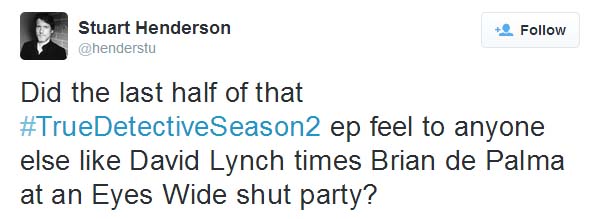
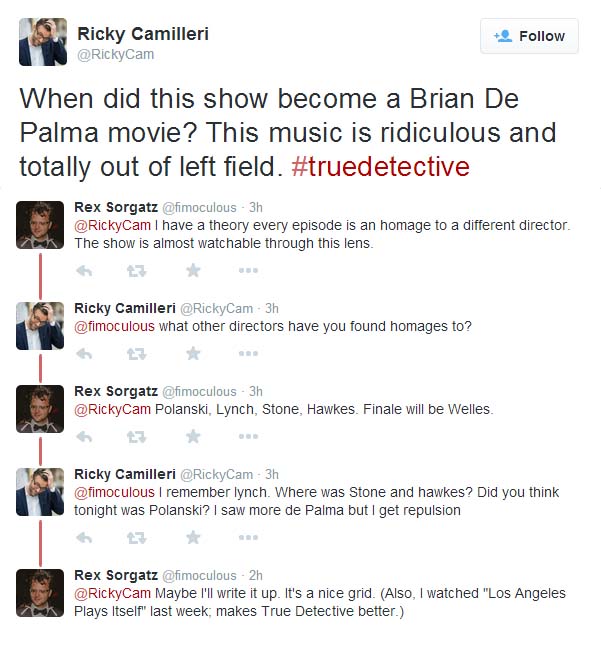
Recapping last night's sixth episode of the second season of HBO's True Detective, JoBlo's Chris Bumbray begins with a summary of the episode's plot: "Bezzerides (Rachel McAdams) goes undercover at a drug and sex fueled party to find a missing woman with info on Caspere's blackmail tape." Later in the recap, Bumbray writes, "Things get insane in the second half when Ani goes undercover at Mayor Chessani's son's sex party, where the mob imports girls for the town's richest men to have their way with. This whole sequence is amazing, with director Miguel Sapochnik (director of Repo Men) expertly staging the Brian De Palma-style set-piece at the party, with the tension being ramped up to an almost intolerable level. I was literally on-the-edge of my seat, helped by McAdams' wired performance as Ani's drugged and starts to hallucinate that the man who molested her as a child is stalking her, while having to fight off armed bodyguards (with some nifty knife work). The shooting, editing and – especially – the T. Bone Burnett soundtrack here deserve top marks, and I think I even preferred this set-piece to the shootout in episode four. It was absolutely masterful."
 Los Angeles Times' Robert Abele reviews The Tribe:
Los Angeles Times' Robert Abele reviews The Tribe:"The Tribe is a vortex of filmmaking style and humanity's darker impulses, during which you may find yourself clawing the seat to resist its severe, sometimes exceedingly graphic pull. But denying its power is tough. A former crime reporter, Slaboshpytskiy has made one of the most unusual and disturbing films about criminality of the new century.
"Before the first image appears, the movie warns you of its gimmick: The characters all communicate in sign language, with no subtitling or narration. As raw as that deal may seem between an ambitious director and foreign-film audiences normally unfazed by language barriers, Slaboshpytskiy uses it to free up his visual storytelling and direction of actors, which is nearly always illuminative.
"It also fosters an abiding appreciation for the gesticulative art of the all-deaf performers, whose interactions — whatever the emotion at hand — have the expressiveness of choreography. Be assured, there's no lack of narrative clarity here, only the persistent sense that nothing cheerful is in store...
"The Tribe is marked not just by wordlessness — the ambient sound makes it not truly silent — but by Slaboshpytskiy's mesmerizing long takes. Each one is a mini-drama of movement, suspense and revelation, whether tracking characters around the rooms, hallways and grounds of the school, or parked in one spot for a scene of mischief, conversation, explicit sex, or, late in the film, an excruciating real-time abortion. It's shooting style, patient yet predatory, that feels one part Eastern European directors' penchant for protractedly gloomy tableaux, one part Brian De Palma in voyeur mode, with a dash of Martin Scorsese articulating the kinetics of gangster life.
"The film is made up of only 34 shots — fewer cuts than Michael Bay would use to film a commercial. But stitched together, the effect is bracingly alchemic in connecting us to a corrosive world, and characters for whom the mobility of sight is everything. Few first films have so confidently executed such a formalist approach to visuals and communication."
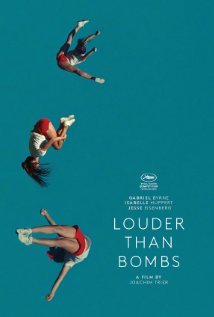 An interesting excerpt from an Cannes 2015 interview with Louder Than Bombs director Joachim Trier, posted yesterday by The Upcoming's Christian Herschmann:
An interesting excerpt from an Cannes 2015 interview with Louder Than Bombs director Joachim Trier, posted yesterday by The Upcoming's Christian Herschmann:Herschmann: How did the diary of Conrad, Isabelle’s youngest son, take shape – a multilayered compilation of a young boy’s mindset and perception?Trier: We had to write it and then write it again and again and again during editing; it was like making a feature film, that diary. We have many versions of it and I’m very happy with the one we used. We even have the clip from Opera by Dario Argento in it. One of our producers is Italian and knows Dario Argento and we got that through him. We wanted to get different elements of different cultural expressions into the diary. We tried to find poetry in the truth of the character. I love the film Kes by Ken Loach. My favourite moment in that film – the one where I always cry – is when the kid, who doesn’t know how to express himself, is suddenly asked by his teacher to talk for the first time and tell them how he takes care of his bird – he knows the boy is with this bird all day. And the kid speaks for the first time and talks freely about who he is. That’s not exactly what we’re doing, but I wanted Conrad’s diary to be a revelation of the discrepancy between his social inability and his inner life, which is so rich.
It is not only a written text in the film, but presented in a very visual way, as a montage of imagery. You used a similar technique in Oslo, August 31st and they both work very well. How did you become interested in this form of expression?
I went to the National Film and Television School in London, we called it National Social Realist Film and TV School. Steven Frears was a teacher there and Mike Leigh, people that I now admire tremendously for their skills in drama, but at the time I was really into Antonioni, Alain Resnais and Brian De Palma. I wanted montage and the break of the image and the form to be really at the essence of what I did, and I think I changed. Also by going to that school, I discovered Ken Loach and the fact that, in the middle of social realism, there is poetry and truth and not only social commentary hitting you on the head. In the best of these films there’s something more that transcends. However, I still have one foot in that kind of formalism. Showing thought patterns in cinema through montage I find very interesting. And it’s been appropriated by commercials, but I always try to show that it could be more expressive and, ideally, more complex.
What do you mean by thought patterns?
The train of thought. How people think. The structuring of thought, which I think is the temporal experience of images on the screen. We always talk about stories, because it’s a literary term and it’s very easy to say, but the fact is we’re watching images in time and they either correlate or don’t with our sensomotoric thought patterns. And it sounds very technical, but I feel it’s a fact, you’re actually dealing with theme and image when you make a movie, all the time. It can be quick or slow: how do you pace the information? Is it possible to express, to show thinking literally, the association chain of a young boy thinking randomly about his life? Yeah, let’s try. That’s what I mean with thought pattern.
There are a lot of memories in the film, a lot of dreams…
That’s what we constitute our identity on, these frail things that we believe are truths about ourselves and that’s very scary and also liberating. AndI feel the film is very much about that: the questioning of identities.

"'Antipasto,' the premiere of Hannibal’s third season (directed by Vincenzo Natali and written by Bryan Fuller & Steve Lightfoot) is arguably the series’ most stylish installment yet. Though Hannibal is regularly a pageant of hypnotic, high fashion horror, its move out of the harsher seasons of the Mid-Atlantic to the wealth and fine arts appreciation of Europe would necessitate it even further. The sensual cinema of Peter Greenaway, De Palma, Bertolucci, Roeg, Peter Strickland—maybe even fucking travel ads—swirl through the streets, the suits, the dresses, the cuisine, the lectures, the wallpaper and yes, the bloodshed."
This past January, a Dressed To Kill action figure of Bobbi was created by Retroband and Gabe Hernandez, at the request of Hannibal series creator Bryan Fuller.
See also previous posts/tweets:
TWEETS: May 16, 2014 Episode of Hannibal brings De Palma to mind for several viewers
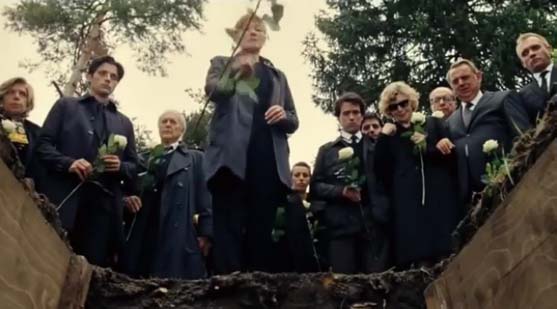
According to GARÇONNE Magazine, Ozon recently revealed to i-D Magazine the five films that inspired The New Girlfriend: Some Like it Hot, In A Year of 13 Moons, Tootsie, Crossdresser, and Dressed To Kill. Of the latter, Ozon told i-D Magazine, "Dressed to Kill is a 1980 film by Brian De Palma. He plays with the idea of gender; it’s a little bit kitsch to watch but there’s a real pleasure there. It’s an erotic thriller centred on a murder, in which Michael Caine cross dresses."
Meanwhile, The Montreal Gazette's T'Cha Dunlevy reports that at TIFF last September, Ozon told him the film was inspired by Alfred Hitchcock, as well as Brian De Palma.
Previously:
Ozon's Young & Beautiful reminds critic of De Palma & Lynch.
 Some quotes noting the influences on Cédric Jimenez' The Connection:
Some quotes noting the influences on Cédric Jimenez' The Connection:"The Connection isn't without its flaws, however. While the comparisons to Mann, De Palma and Scorsese are apt, it runs into trouble when it can't live up to its influences. Outside of some of the colorful flourishes reminding me of De Palma, this is very much a Michael Mann film though it lacks in Mann's control of sound, the hammering of gunfire Mann jars you out of your seat with, and the score and soundtrack is far from what Mann would deliver. A verbal confrontation between Tany and Michel almost immediately conjures memories of the sit down between Pacino and De Niro in Mann's Heat and if you're going to bring to light those comparisons you better be operating at the highest level and as much as I found it entertaining, The Connection can't stand with the big boys.
"But this isn't to diminish this movie in any way. As a piece of period entertainment, The Connection is rock solid."
"Jimenez has done well with this high-budget piece, and it’s a sure winner in its native country. The writing is not the best, however, the acting is superb, the soundtrack is fantastic and the cinematography is at times stunning. It’s clear there’s been an influence from the likes of many cat-and-mouse crime thrillers; the work of Martin Scorsese, Brian De Palma, and even Quentin Tarantino is significant within The Connection, as various scenes clearly remind viewers of those from Goodfellas, The Untouchables, The Departed, and Scarface. Particular moments set in the Krypton club leave viewers almost expecting to see Tony Montana giving the famous stare."
Rob Hunter, Film School Rejects
"The Connection mixes elements from other films — Heat, The Untouchables — with its own style to tell a familiar tale well. It creates a world and pulls you in only to remind you at the end that this warm, sunny fantasy is actually the cold, dark world called reality."
Frank J. Avella interviews Cédric Jimenez at EdgeBoston.com
The film's look is dazzling, stunning, yet, quite gritty. "We shot in 35mm, which is always really beautiful. There's something special with 35mm that you can never have in HD. I am very close with my DP (Laurent Tangy). And I told him, we have to adapt the aesthetic of the movie around the story and not the story around the aesthetic...the shooting had to be instinctive."
It's easy to watch the film and get a certain Scorsese/"Mean Streets" sense. Jimenez acknowledges his influences, "Of course you can see the '70s American cinema like Scorsese, Coppola, Friedkin, Brian dePalma, for sure. I also love the French gangsters cinema, too, like Verneull, Melville. And Italian cinema."
What is interesting is that he says he didn't screen any of the works of those filmmakers to prep for "The Connection," Instead he watched Alejandro Inarritu films (like "Babel") and Darren Aronofsky's work, "looking for reality and looking for something very intense and very visceral." He adds, "But in the end you have you make your own movie with your own personality."
"The Connection," which will be released here by Drafthouse Films, marks the self-taught director's third feature after getting his start as a producer a decade ago. He's currently working on an English language film with American actors but didn't want to elaborate further.
 Wikipedia says that "Soda Stereo [was] an Argentine rock band that is considered by critics to be the most important and influential Ibero-American band of all time and a Latin music legend." The band's most famous song, Persiana Americana (1986), is likewise considered to be the most famous rock song in Spanish, chanted in stadiums throughout Latin America, according to Intemperie's Laura Quiceno.
Wikipedia says that "Soda Stereo [was] an Argentine rock band that is considered by critics to be the most important and influential Ibero-American band of all time and a Latin music legend." The band's most famous song, Persiana Americana (1986), is likewise considered to be the most famous rock song in Spanish, chanted in stadiums throughout Latin America, according to Intemperie's Laura Quiceno.The next day, band member Gustavo Cerati called him and said he really liked that one, but wanted something more "romantic." So Daffunchio then "wrote a second version, and this time I thought of Dressed To Kill by Brian De Palma."
And the rest is history-- you can hear the song on YouTube.
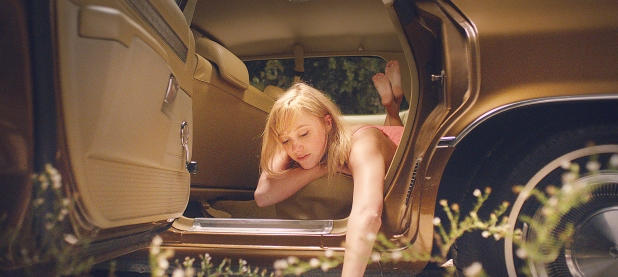
AVC: There’s a lot of vintage John Carpenter in this film, especially in the music and the use of space. Was he a big influence, and were there other filmmakers whose work you studied when bringing the movie to life?DRM: Of course, I totally love Carpenter—Halloween, and his version of The Thing is a favorite of mine. I’ve definitely watched his movies a million times. I’m a fan of his blocking and his staging and his compositions. For me, it wasn’t just about saying, “This particular shot is a Carpenter homage.” I’ve watched his stuff enough that’s probably going to come out in the filmmaking. But there’s a ton of other filmmakers that factored in, too. I also love Cronenberg, I’m a big De Palma fan—I think there’s probably a lot of De Palma in there as well. Hitchcock, too. Rear Window is my favorite movie of all time. I love Creature From The Black Lagoon. I could go on and on about all the people that I love. And then there are other elements of the movie that are not necessarily the horror elements. Some of the inspiration for that comes from a lot of different places, few of them having anything to do with horror.
AVC: Do you have rules about how you write teenage characters? One of the interesting things about It Follows is that it features kids who don’t talk in references or relate everything to something they’ve seen.
DRM: Yeah, there’s an avoidance of certain aspects of pop culture, but then I like to embrace other parts of it. It’s tricky, because I’ve only made these two films, but I have a million different scripts and a million different things that I want to make. The two that I’ve done have just been about teenagers, but I have stories about many different characters at many different stages of life.
It more has to do with my general belief that film doesn’t have to operate within the world we live in. The ground rules of the film world don’t have to be how we understand the world. And something doesn’t have to be fantasy to take some elements from fantasy. Movies are very much dreams, in a way, and you can use that to your advantage.
AVC: The time period of the movie is fascinatingly indeterminate. One of the girls has this mobile device, but otherwise we could be watching a movie set in 1990.
DRM: There are production design elements from the ’50s on up to modern day. A lot of it is from the ’70s and ’80s. That e-reader cell phone—or “shell phone”—you’re talking about is not a real device. It’s a ’60s shell compact that we turned into a cell phone e-reader. So I wanted modern things, but if you show a specific smartphone now, it dates it. It’s too real for the movie. It would bother me anyway. So we made one up. And all of that is really just to create the effect of a dream—to place it outside of time, and to make people wonder about where they are. Those are things that I think happen to us when we have a dream.
AVC: Plenty of people have read the “It” of It Follows as a metaphor for a sexually transmitted disease, but that doesn’t entirely scan, as you can’t get rid of an STD by sleeping with someone else.
DRM: [Laughs.] Right, exactly. I was totally aware of that connection when I wrote the script, but it wasn’t necessarily the driving force in terms of subtext. There are a lot of other aspects. I tend to shy away from explaining it, but I’m happy to have the conversation.
AVC: Of course, you don’t need to unpack your own film. That’s for us to do.
DRM: [Laughs.] But I would agree with you that even if you read it that way, it’s much more complicated than that.
AVC: You mentioned Brian De Palma earlier. He’s a director who builds his film around set pieces, and I feel as though the scary moments in It Follows are essentially set pieces, too. Did you write all of them into the script or were there any moments born when you were on location?
DRM: Oh, no, it’s all in the script. There are small elements that we worked out on set. But we didn’t have a ton of money, so it was about having a really solid plan and going in and doing everything in our power to get it done. There was very little time to change things once we got going.
So I worked those [set pieces] out in my head beforehand. Most of that stuff was probably in the first draft of the script. A few things changed. Some set pieces became smaller because of budget. There were a couple of really cool ideas from the first draft that would have been really fun to do, but we would have just needed a lot more money and people. I had a lot of ideas of ways you could use the rules of this monster to generate suspense and create some really interesting set pieces. And I only got to do a few of them in the film, really.
"This week's superb chiller It Follows (read our review) has been frequently described as a 'throwback,'" Taylor begins. "This probably has to do with the film, which concerns a teenage girl (Maika Monroe from the similarly wonderful The Guest) who is stalked by a ghoul following an untoward sexual encounter, feeling like it's from another era. The synth-heavy electronic score (check out a few cuts here) is straight out of the '80s, while other aspects feel eerie and timeless in a way that few modern day horror films do. We sat down with director David Robert Mitchell and talked about the five biggest influences on It Follows, and some are as surprising as the movie itself.
"Throughout the course of our conversation, we talked about a number of influences that come to bear on the film — from the French New Wave to the stylized camera trickery of Brian De Palma (Mitchell says he didn't tell his financiers about his intention to shoot so many extremely long takes), from the hollowed-out city of Detroit to the suburban horror of Poltergeist. But the following five influences are the most significant to Mitchell —these were the films that he first referenced and had no problem elaborating on. Some of the films' DNA is easy to spot in It Follows, while others function more as spiritual successors. But all of it enhances Mitchell's work, and it's easy to think that in a few years some young director of the next horror sensation will cite It Follows as a reference."
The five main influences on It Follows, according to the article, are Creature from the Black Lagoon, George Romero's Night of the Living Dead," John Carpenter (and Howard Hawks' The Thing from Another World), Wes Craven's Nightmare On Elm Street, and Wim Wenders' Paris, Texas.
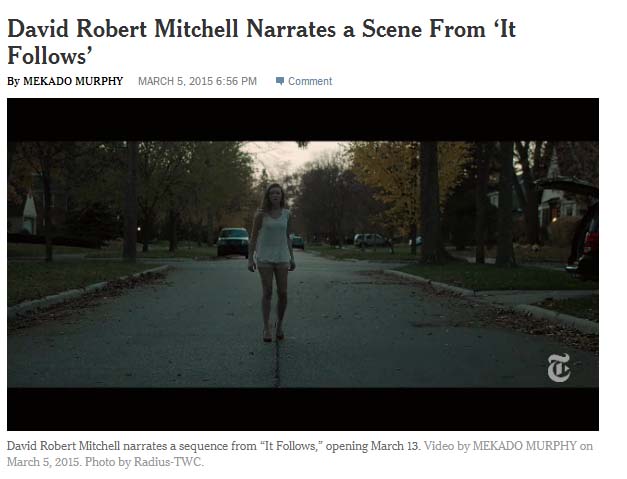
"So this is the opening shot of the film. We’re starting with this sort of slow, kind of calm, objective shot of this middle class neighborhood. And we see this girl running in fear. We’re not really sure what it is that she’s running from, or what she’s scared of. Maybe a play on a bit of a cliché, some of this is, right down to the wardrobe is… she’s in high heels, which I’ve had some people point out, questioning, ‘does that make a lot of sense?’ And the answer is no. It’s definitely a bit of a play on the conventions of horror, all the way back to referencing women in peril, from even De Palma movies, for instance. You’ll notice throughout this sequence… we did this in… it’s in one shot. It’s playing on this idea of us being sort of colder observers of this terrible thing happening, and we’re on the outside of it."